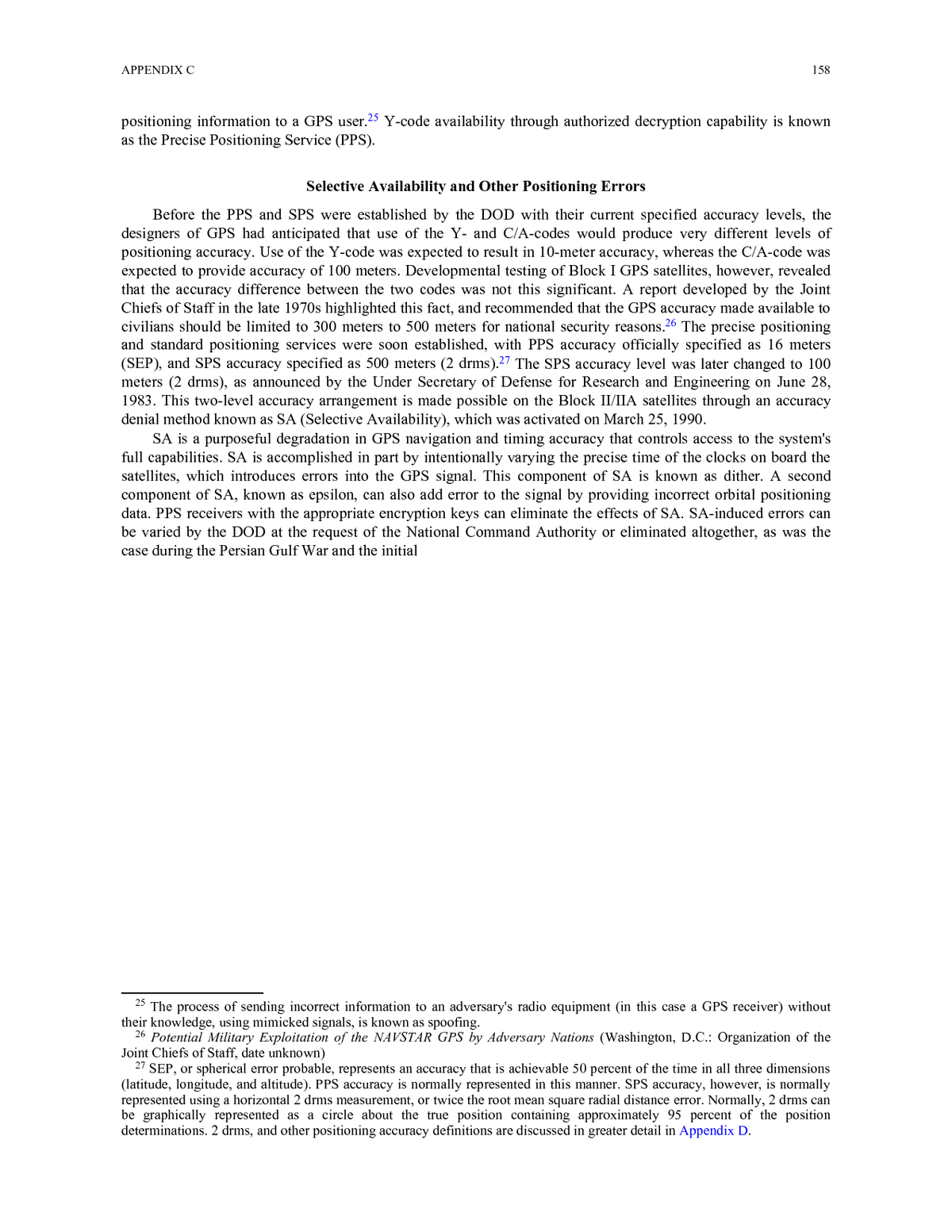Below is the uncorrected machine-read text of this chapter, intended to provide our own search engines and external engines with highly rich, chapter-representative searchable text of each book. Because it is UNCORRECTED material, please consider the following text as a useful but insufficient proxy for the authoritative book pages.
APPENDIX C 158 positioning information to a GPS user.25 Y-code availability through authorized decryption capability is known as the Precise Positioning Service (PPS). Selective Availability and Other Positioning Errors Before the PPS and SPS were established by the DOD with their current specified accuracy levels, the designers of GPS had anticipated that use of the Y- and C/A-codes would produce very different levels of positioning accuracy. Use of the Y-code was expected to result in 10-meter accuracy, whereas the C/A-code was expected to provide accuracy of 100 meters. Developmental testing of Block I GPS satellites, however, revealed that the accuracy difference between the two codes was not this significant. A report developed by the Joint Chiefs of Staff in the late 1970s highlighted this fact, and recommended that the GPS accuracy made available to civilians should be limited to 300 meters to 500 meters for national security reasons.26 The precise positioning and standard positioning services were soon established, with PPS accuracy officially specified as 16 meters (SEP), and SPS accuracy specified as 500 meters (2 drms).27 The SPS accuracy level was later changed to 100 meters (2 drms), as announced by the Under Secretary of Defense for Research and Engineering on June 28, 1983. This two-level accuracy arrangement is made possible on the Block II/IIA satellites through an accuracy denial method known as SA (Selective Availability), which was activated on March 25, 1990. SA is a purposeful degradation in GPS navigation and timing accuracy that controls access to the system's full capabilities. SA is accomplished in part by intentionally varying the precise time of the clocks on board the satellites, which introduces errors into the GPS signal. This component of SA is known as dither. A second component of SA, known as epsilon, can also add error to the signal by providing incorrect orbital positioning data. PPS receivers with the appropriate encryption keys can eliminate the effects of SA. SA-induced errors can be varied by the DOD at the request of the National Command Authority or eliminated altogether, as was the case during the Persian Gulf War and the initial 25 The process of sending incorrect information to an adversary's radio equipment (in this case a GPS receiver) without their knowledge, using mimicked signals, is known as spoofing. 26 Potential Military Exploitation of the NAVSTAR GPS by Adversary Nations (Washington, D.C.: Organization of the Joint Chiefs of Staff, date unknown) 27 SEP, or spherical error probable, represents an accuracy that is achievable 50 percent of the time in all three dimensions (latitude, longitude, and altitude). PPS accuracy is normally represented in this manner. SPS accuracy, however, is normally represented using a horizontal 2 drms measurement, or twice the root mean square radial distance error. Normally, 2 drms can be graphically represented as a circle about the true position containing approximately 95 percent of the position determinations. 2 drms, and other positioning accuracy definitions are discussed in greater detail in Appendix D.
APPENDIX C 159 operations in Haiti.28 Figure C-7 displays the specified positioning, timing, and velocity accuracies for both the SPS and the PPS.29 Figure C-7 PPS and SPS specified accuracies. (Courtesy of the GPS JPO) In practice, there are several additional sources of error other than selective availability that can affect the accuracy of a GPS-derived position. These include unintentional clock and ephemeris errors, errors due to atmospheric delays, multipath errors, errors due to receiver noise, and errors due to poor satellite geometry. Each of these error sources is discussed below and summarized in Table C-1. 28 Selective Availability is normally on, but the level of error added to the GPS signal can be set to zero. 29 It should be noted that these are specified accuracies not observed accuracies. Many GPS receivers currently in use are able to achieve better results than the specifications call for.


